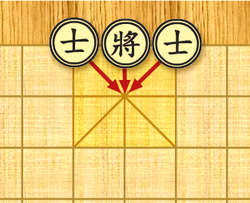Xiangqi
Xiangqi is a board game from China. In English, it is also known as Chinese chess.
Though derived from the original Indian Chaturanga, Chinese chess is quite different from modern international chess. The board is different, there are different pieces, and they have different moves. The general and his mandarin may not leave the nine-pointed fortress; they have only limited movement. Clearly, this is more similar to the old Indo-Arabic game than to modern chess.
Xiangqi is a chess game for two people to play. Each player's palaces are located at the back row of their side with an X shaped. Each player has 16 pieces to move on the board. One player's set is red, and the other is black. The way to win is to checkmate or stalemate the other player's King. Each kind of piece has different ways to move. Xiangqi is one of the most popular chess games in China.[1][2]p78
Pieces
Movement
- General: Moves one step vertically or horizontally and it only stays inside the palace.
- Advisor: Moves one step diagonally and it only stays inside the palace.
- Elephant: Moves exactly two steps diagonally and it cannot jump over a piece or cross the river.
- Horse: Moves like the knight in chess, but it cannot jump over a piece vertically or horizontally (diagonals are fine). It is known as blocking the horse leg.
- Chariot: Moves like the rook in chess and it cannot jump over a piece.
- Cannon: Moves the same as the Chariot but to capture, the cannon needs to jump over exactly one piece and then land on the other side.
- Soldier: Moves one step forward and after it crosses the river, the soldier can also move sideways.
Points
- General: Infinite points
- Chariot: Nine points
- Cannon: 4.5 points in opening and four points in endgame, because the cannon in the endgame has less pieces to jump for capturing.
- Horse: Four points in opening and 4.5 points in endgame, because it can be more easily blocked (mostly in crowded positions) in the opening than in the endgame.
- Elephant: Two points in opening and 2.5 points in endgame, because the elephant in the opening can be blocked in the opening than the endgame.
- Advisor: Two points
- Soldier: One point before it crosses the river and two points after it crosses the river.
Special rules
- Flying General: Generals cannot stand on the same column unless there is one piece between them.
- Stalemate: A stalemate in Xiangqi is not a draw, but a lost for the player that gets stalemated.
Xiangqi Media
Two men are playing chess on holiday, Hanoi in August 3, 2025.
Related pages
References
- ↑ Pritchard, David Brine 1994. The Encyclopedia of chess variants. ISBN 0-9524142-0-1
- ↑ Hooper, David & Whyld, Kenneth 1992. The Oxford Companion to Chess 2nd ed, Oxford University Press. ISBN 0-19-866164-9



